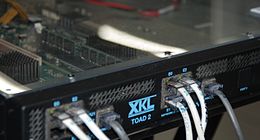XKL
 | |
| Company type | Private |
|---|---|
| Industry | Telecommunications Optical networking Computer Networking |
| Founded | 1991 |
| Founder | Len Bosack |
| Headquarters | , |
Area served | Worldwide |
Key people | Len Bosack and Sandra Lerner |
| Products | Darkstar Optical Network Hardware |
| Website | www |
XKL, LLC is an American company that develops optical transport networking technologies.[1] Founded in 1991 and based in Redmond, Washington, XKL is led by Cisco Systems co-founder Len Bosack.
History of XKL
In its earliest days XKL developed, and in 1995 introduced, the TOAD-1, a compact, modern replacement for PDP-10 systems, mainframe computer systems that had gone out of production.[2]
Products

Current products
Products include transponder, muxponder, mux/demux (multiplexing/demultiplexing) and (optical) amplifier models.
DarkStar DQT10 Transponder
Supports 12, 24 or 36 10G channels.
DarkStar DQT100 Transponder
Aggregates up to 96 100G channels onto a single pair of fibers.
DarkStar DQT400 Transponder
Aggregates up to 48 100G / 400G channels
DarkStar DQM100 Muxponder
Aggregates up to 12 100G channels via statistical multiplexing.
DarkStar DQM10 Muxponder
Aggregates up to 36 10G channels.
DarkStar DSM10-10 Muxponder
Aggregates up to 100G services.
DarkStar DXM
First released in 2007, the Darkstar DXM is a high-performance optical switch first installed at the California Institute of Technology as part of their Supercomputing Bandwidth Challenge. It provides 5 times the bandwidth, in excess of 100 Gigabits/sec, than the existing system but is also smaller and uses less power.[3]
Historical products
TOAD-1
The TOAD-1 System, also known as TD-1,[notes 1] was announced in 1993 and built as an extended version of the DECSYSTEM-20 from Digital Equipment Corporation. The original inspiration was to build a desktop version of the popular PDP-10 and the name began as an acronym for "Ten On A Desk". It was eventually built at XKL by veteran engineers from Cisco, DEC, Hewlett-Packard, and CDC.[4]


It was the first XKL product produced and it became available for purchase in late 1995. The TOAD-1 is a high-performance I/O oriented system with a 36-bit processor running TOPS-20. It is multi-user system that can provide service to over 100 users at a time. The TOAD-1 architecture incorporates modern peripherals, and open bus architecture, expanded physical and virtual memory while maintaining the TOPS-20 user environment.[1]
TOAD-2
The TOAD-2 was built to replace the TOAD-1. It is a single chip reimplementation used as redundant control processors in networking equipment from XKL. It can be configured for TOPS-20 timesharing.[4]
See also
Other companies that produced PDP-10 compatible computers:
Notes
- ^ The TOAD-1 was referred to as the TOAD as a development codename and then changed to the TD-1 as the original marketing name. It was then switched back to TOAD-1 before production began.
References
- ^ a b "XKL Flier". Retrieved 29 June 2016.
- ^ "LCM+L - XKL TOAD-1 System". livingcomputers.org. Living Computers: Museum + Labs. Retrieved 26 April 2022.
- ^ "XKL, LLC: XKL Supports Caltech in Supercomputing '08 Bandwidth Challenge". Internet Archive: Wayback Machine. 6 October 2009. Archived from the original on October 6, 2009. Retrieved 12 July 2016.
- ^ a b "Exhibits - Living Computer Museum". www.livingcomputermuseum.org.
- Duffy, Jim. "Cisco founder wants to go faster, farther". Network World. Retrieved 2009-06-01.
- "Len Bosack and XKL introduce "Do It Yourself Optical Networking"". GLG Group. Retrieved 2007-08-08.
- "Cisco Founder Pushes for DIY Optical Networks". Light Reading. Retrieved 2009-07-03.
- "Len Bosack speaks with Erik Linask at ITEXPO". TMCNet. Retrieved 2010-10-06.
External links
- Official website
- Login into the Living Computer Museum, a portal into the Paul Allen collection of timesharing and interactive computers, including an operational XKL TOAD-2
